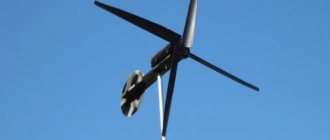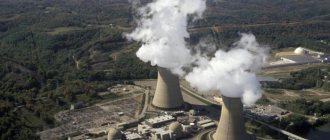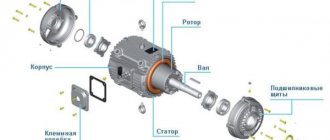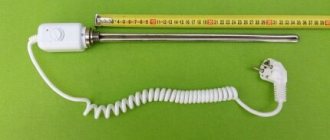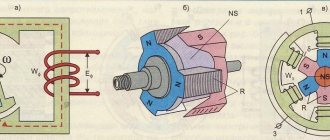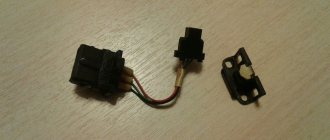Wind turbines have been used as a source of electricity for decades. For the first time, people began to exploit such structures when they harnessed the power of nature and began to build mills. Today, turbine-type wind generators of the third generation are used to produce electricity. Moreover, the structures themselves have recently acquired increasingly unusual forms.
Main characteristics
As with any technical device, so with an air turbine, the parameters that classify its capabilities, as well as providing information about a particular model, are its technical characteristics.
The main technical characteristics for such devices are:
- Rated output power, measured in kW.
- The rated rectified voltage that the generator produces at a certain rotor speed of the installation.
- The frequency of the generated voltage, measured in Hz.
- The rotor rotation frequency, in operating mode, at which the rated rectified voltage is created. Measured in revolutions per minute.
- The rated speed at which a wind turbine meets its declared power. Measured in revolutions per minute.
- Stealth speed is measured in revolutions per minute and classifies the maximum ability of the unit to operate at a certain speed.
- An operating mode in which a particular device model is capable of operating for a specified time (long-term, cyclic, short-term, etc.).
- The level of noise (sound) produced during operation of a particular model is measured in dB.
- Device efficiency.
- Type of cooling of components and mechanisms.
- Method of installation and assembly.
- Dimensions.
- Unit weight.
Features of choice
The main criterion that buyers follow is the size of the wind turbine. The larger its size, the higher the power generated. Therefore, when choosing wind power plants for your home, you need to calculate your monthly energy consumption in advance. The result obtained is multiplied by 12 months.
Further calculations for a private house are carried out using the formula: AEO = 1.64 x D x D x V x V x V, in which AEO is the electricity consumed per year, D is the rotor diameter in meters, V is the average annual wind speed in m/s . By substituting the required values, you can easily calculate the dimensions of the required installation.
When purchasing a power plant, you should think in advance about its location. In this case, the following factors are taken into account:
- The area near the generator must be free of buildings, structures, trees and other factors that reduce the productivity of the installation. The existing interference is located at a distance of no closer than 200 meters from the installation site.
- The height of the structure for mounting the generator must be at least 2-3 meters higher than the interference in the adjacent area.
- The distance from residential buildings is at least 30-40 m, since when the blades rotate, some noise is created, causing some discomfort to others.
- It is necessary to take into account the average annual changes in weather conditions, when different amounts of electricity will be generated in the same place during the year.
Design features of a wind turbine
Wind generators equipped with a wind turbine are a cylinder with blades inside. The presence of an external contour around the blades provides them with protection from foreign objects and living organisms getting into them.
The absence of the need for a tail section (for orientation relative to the wind direction) reduces the weight and dimensions of the device, and also facilitates installation and operation. The body, in the form of a cylinder, is independently oriented in the direction of wind flows, and, essentially working as a nozzle, increases the pressure on the installed blades, thereby increasing the efficiency of the wind generator.
How to calculate correctly
The main indicator that determines the choice of a particular model is the ability to generate electrical energy, which is measured in kilowatt hours per unit time.
The amount of energy generated is directly related to the power of the installation, which is the main technical characteristic of the unit, therefore the calculation of the wind turbine determines its geometric dimensions, the number of installed blades and the installation height above the ground.
The power of the electric generator, which determines the ability of a wind turbine to generate electric current, depends on the wind flow, the power of which, in accordance with the efficiency of the turbine, can be calculated using the formula:
P=KxRxV3xS/2
Where:
P – air flow power;
K – coefficient taking into account the efficiency of the turbine, has a value from 0.2 to 0.5 units;
R – air density, is 1.225 kg/m3 (at normal atmospheric pressure);
V is the speed of air flow, measured in m/s;
S – coverage area of the wind turbine (wind flow operating with the installation).
From the above formula it is clear that the power of the wind flow, and, consequently, the power of the generator, directly depends on the diameter of the wind turbine (S= π R2).
Knowing the speed of air flow at the installation site and its diameter, it is possible to determine the power of the installation and its ability to generate electrical energy.
Wind turbine - criteria for operation in domestic conditions
For people living in off-grid areas, wind and solar energy seem to be a useful combination for use. Nature often demonstrates a situation where the sun is hidden behind the clouds, but the wind is blowing. And vice versa. The presence of a wind turbine for an autonomous power system allows you to have fewer solar panels and a smaller volume of electricity storage battery.
The efficiency of solar and wind energy depends largely on the availability of such natural resources. Where sunlight is available for 300 days or more during the year, it makes sense to generate solar energy in such areas. However, along with the energy of the sun, there is also a wind resource in the area. Therefore, as a rule, both types of energy are successfully combined together.
The combination of two technologies for generating renewable electrical energy is a successful solution for installing systems in regions with variable weather
On the contrary, there are areas of the Earth where sunlight is not available for weeks at a time. For such regions, wind energy is considered the most cost-effective solution. When people live far enough from the nearest utilities, the use of wind energy appears to be economical compared to other options.
Home wind generator and disconnection from the general power grid
The option of disconnecting from the centralized energy supply is not excluded, but it is unlikely to reduce the cost and economic efficiency of operating a home windmill. It's not for nothing that many companies selling wind energy systems for homes tend to only advertise the equipment criteria that potential customers want to see.
Those wishing to take a risk and install a home windmill are advised to first conduct a thorough analysis of the topic - find information provided by objective sources that are not “tied up” with sales.
Many good books have been published on the topic of wind energy, and there is also material on the Internet. It's a smart idea to learn the ins and outs of wind energy before you start spending money on a home project.
Generating your own electricity is in most cases more expensive than purchasing energy through a commercial power grid. The cost of energy harvesting and storage batteries alone can be comparable to purchasing the same energy from a commercial grid.
Energy generation costs vary depending on the equipment purchased, dramatically changing the overall cost per kilowatt-hour for an off-grid system. However, the modern world is seeing a trend towards scaling up the use of wind energy in a private home.
And for projects involving the operation of larger machines, this approach seems to be cost-effective with a fairly short payback period. In general, when thinking about creating your own energy in order to reduce your electricity bills, it is advisable to do everything possible to save.
Facts regarding home wind power
Quite a lot of misleading information is found today on the topic of generating wind energy using small-sized home installations.
Because accurate wind speed is extremely difficult to measure and many potential customers are poorly informed, it is easy to make unrealistic claims about the performance of residential wind turbines.
Unless installing several copies of wind generators on the roof of a private house opens up the possibility of using more than one incandescent light bulb, not to mention other electrical appliances
Below is one of the main wind energy formulas, which calculates wind energy (but not extractable energy):
Pw = ½ * rho * A * V3
Here: rho = 1.23 (air density constant); A = area described by the turbine impeller, m2; V = wind speed, m3.
Wind Turbine Performance Examples
For example, a wind turbine at home has a blade diameter of 3 meters, the area described by the impeller is just over 7 m2. Doubling the impeller diameter will result in a 4-fold increase in area. The power received from a wind turbine is directly related to the “square” of the blade diameter.
Doubling the wind speed results in 8 times more energy. This point is also very important. If a home wind turbine is designed to produce useful power at a wind speed of 15 km/h, the design has to deal with an 8-fold increase in energy at a wind speed of 30 km/h.
Approximately 64 times more energy will be obtained at a wind speed of 60 km/h. If the air flow speed reaches 120 km/h, the energy obtained is 512 times greater. Obviously, in order to maintain the operation of the wind turbine and support tower, some kind of system is needed to protect the entire installation.
Meanwhile, the best result that can be obtained from a wind turbine at home is 55-59% of the power obtained using the above formula. That is, theoretically, a wind turbine with a blade diameter of 1.5 m is capable of producing 59 W at a wind speed of 15 km/h.
This is what home wind generators look like, capable of generating no more than 50 watts of electricity provided they rise to a height of 30-35 meters relative to the highest point of the area
In practice, it is almost impossible to produce a wind turbine impeller blade with an ideal shape. However, even an ideal small wind turbine impeller blade can only achieve 30-35% efficiency.
Thus, a wind turbine impeller blade with a diameter of 1.5 m produces about 30 W of power at a wind speed of 15 km/h and no more. However, we are talking only about the mechanical energy on the shaft, without taking into account the efficiency of the alternator / generator, where there are also losses.
Electrical efficiency of a wind turbine for home use
Most small wind turbines have good electrical efficiency in low winds. These same designs tend to become less efficient in high winds.
In light winds and stronger winds (40-50 km/h) an electrical efficiency of 80% should be expected. However, efficiency is often reduced by about 50% unless power electronics are used to better match the rotation of the impeller blades to the rotation of the alternator/generator shaft.
It is logical to use the above formula when the goal is to see the amount of energy available in the wind at any known wind speed. Any claims made about energy yields greater than 59.2% definitely violate the laws of physics.
Any claims made about a machine being more than 30% efficient or so are also unrealistic. This is important to keep in mind against the backdrop of widespread incorrect statements from various manufacturers regarding home wind turbines.
Impeller coverage area + rated power
For a wind turbine, the "power rating" value seems meaningless compared to the area covered by the impeller (screw). For domestic practice, “lightweight” small wind turbines that reach a power of 1000 W are seen as desirable designs, even if only produced in strong winds.
At the industrial level, large, heavy, low-speed wind generators are used, which can easily provide the same power of 1000 W or more, but with a much weaker wind flow. However, industrial structures are clearly not comparable in size to domestic wind power plants.
This kind of industrial installation already allows us to talk about really high power generated electricity. But even such a system is not enough in a single copy
It should be remembered: the strength of the wind is directly related to the “cube” of the wind speed. So, in conditions of a wind speed of 40 km/h, the power is twice as high as at a wind speed of 30 km/h.
Thus, a small wind turbine producing 1000 W of power at a wind speed of 50 km/h is not comparable to a larger wind turbine of the same power of 1000 W but producing at a wind speed of 30 km/h.
Slow winds in the speed range of 15-25 km/h are the most common on Earth. On the contrary, winds blowing at a speed of more than 40 km/h are extremely rare. In fact, the difference in “average” wind speed between a successful and unsuccessful installation point is less than 10 km/h.
Often there are commercial offers for home wind generators with rotors with a diameter of 2 meters, marked with a power of 2 kW. Perhaps in a hurricane such a wind turbine is capable of producing 2 kW. In reality, machines with a rotor part with a diameter of less than 2.5 meters are capable of generating no more than 25 W from a wind flow of 3–6 km/h.
It is unlikely that most wind turbines are capable of spinning at speeds below 8 km/h. Even if the structure picks up rotation under such conditions, the machine will not produce more than 5-6 watts from an impeller with a diameter of 2.5 meters at a wind speed of 6 km/h.
Accordingly, when purchasing (manufacturing) a wind turbine, the important consideration is the coverage area, rather than the rated output specified by the equipment manufacturer.
Mast (tower) of a domestic wind turbine
There is a purely commercial opinion that the most economical option is to install a large number of wind turbines on short masts or install wind turbines directly on the roof of a house. Wind turbine manufacturers can be understood - selling a wind turbine together with a tower costs money, and buyers do not like the additional cost/installation effort.
Homemade wind generator made using 3D printing technology. The power of such a device is up to 100 watts, provided the air flow speed is at least 25 km/h
However, any type of wind turbine requires clean, non-turbulent “fuel”. It is extremely difficult to provide such “fuel” to a windmill on the ground or even on the roof of a house.
Professional installers and wind turbine manufacturers say that the most cost-effective option is to install the wind turbine 10 meters above anything located within a 100-meter circle from the installation point of the wind turbine.
When there is a turbulent air flow of 15 km/h at a height of 10 meters and a smooth air flow of 20 km/h at a height of 20 meters, it makes sense to raise the equipment above 20 meters. Due to the additional rise, it will be possible to get out of the turbulence mode and obtain a higher rotation speed.
Then there is a doubling of energy. Most quality wind energy installations have a support tower cost that is much higher than the cost of the individual wind turbine structure. But this cost difference is justified for good reasons.
Types of wind turbines
Although it was initially believed that a wind installation with a wind turbine involves its installation only in a horizontal plane, which characterizes wind generators with a horizontal axis of rotation, nevertheless, designers have developed new versions of such devices, which are:
Vertical axis wind turbine
In installations of this type, the turbine cylinder is located vertically, and the blades are in a plane perpendicular to the surface of the earth.
The operation of wind turbines with a vertical axis of rotation is similar to the operation of devices with a horizontal axis of rotation.
Wind turbine without blades
The presence of blades in wind turbines of various designs leads to the fact that their installation requires significant areas, even if these are wind turbines located in a rigid casing. In this regard, a new direction in the development of wind turbines has been the construction of similar devices using wind turbines that do not have blades.
This design consists of a pillar with metal disks inside. The discs are mounted on the shaft and located parallel to each other, with special gaskets installed between them. When air hits the gaskets, they begin to move and give a certain and directed impulse to the metal disks, under the influence of which the disks begin to rotate. Under the influence of the rotational movement of the disks, the rod begins to rotate, which in turn transmits its rotational motion to the generator shaft.
Wind turbine for roof
Interest in the ability to provide oneself with free electrical energy, without creating problems for others, even in a city, led to the development of a wind turbine design that can be installed on the roof of any building.
Such an installation has small overall dimensions, light weight, and is practically silent during operation. The outer body of the device is made in the form of a snail, which allows you to increase the wind flow in the desired direction and orient yourself in space in accordance with its direction.
Wind turbine calculation
Where to start calculating a system for generating electricity from wind energy? Considering that we are talking about a wind generator, a preliminary analysis of the wind rose in a specific area seems logical.
Calculation parameters such as wind speed and its characteristic direction for a given territory are important design parameters. To some extent, they determine the level of wind turbine power that will actually be achievable.
It’s hard to even imagine wind generators of such power. But such designs exist and work effectively. However, calculations of such structures show relatively low power compared to traditional energy sources
What is noteworthy is that this process is long-term in nature (at least 1 month), which is quite obvious. It is impossible to calculate the maximum probable parameters of wind speed and its most frequent direction with one or two measurements.
Dozens of measurements will be required. However, this operation is really necessary if there is a desire to build an effective productive system.
How to calculate the power of a windmill
Wind generators for domestic use, especially those made by hand, have never surprised people with high power. This is understandable. One has only to imagine a massive mast 8-10 m high, equipped with a generator with a propeller blade span of more than 3 m. And this is not the most powerful installation. Just about 2 kW.
To service wind turbines of this power, helicopters and teams of specialists numbering up to a dozen people are used. To calculate such a power plant, an even larger number of performers are involved
In general, if you rely on a standard table showing the relationship between the power of a wind generator and the required span of the propeller blades, there is something to be surprised about. According to the table, a 10 W windmill requires a two-meter propeller.
A 500-watt design will require a propeller with a diameter of 14 m. Moreover, the blade span parameter depends on their number. The more blades, the smaller the span.
But this is just a theory, conditioned by wind speeds not exceeding 4 m/sec. In practice, everything is somewhat different, and the power of household installations that actually operate for a long time has never exceeded 500 W.
Therefore, the choice of power here is usually limited to the range of 250-500 W with an average wind speed of 6-8 m/sec.
Table of the dependence of the power of a wind energy system on the diameter of the rotor and the number of blades. This table can be used for calculations, but taking into account its compilation for wind speed parameters up to 4 m/sec (+)
From a theoretical position, the power of a wind power station is calculated using the formula:
N=p*S*V3/2,
Where:
- p – density of air masses;
- S – total blown area of the propeller blades;
- V —air flow velocity;
- N – air flow power.
Since N is a parameter that radically affects the power of a wind generator, the actual power of the installation will be close to the calculated value of N.
Calculation of wind turbine propellers
When constructing a windmill, two types of propellers are usually used:
- winged - rotation in a horizontal plane;
- Savonius rotor, Darrieus rotor - rotation in a vertical plane.
Screw designs with rotation in any plane can be calculated using the formula:
Z=L*W/60/V
Where:
- Z – degree of speed (low speed) of the propeller;
- L – size of the length of the circle described by the blades;
- W – speed (frequency) of rotation of the propeller;
- V – air flow speed.
Based on this formula, you can easily calculate the number of revolutions W - rotation speed.
This is what the design of the screw called the “Darieu Rotor” looks like. This version of the propeller is considered effective in the manufacture of wind generators of small power and size. The calculation of the screw has some features
And the working relationship between revolutions and wind speed can be found in tables that are available on the Internet. For example, for a propeller with two blades and Z=5, the following relation is valid:
| Number of blades | Degree of speed | Wind speed m/s |
| 2 | 5 | 330 |
Also, one of the important indicators of a windmill propeller is the pitch.
This parameter can be determined using the formula:
H=2πR* tan α,
Where:
- 2π – constant (2*3.14);
- R – radius described by the blade;
- tan α – section angle.
Additional information on choosing the shape and number of blades, as well as instructions for their manufacture, is provided in this article.
Selection of generators for wind turbines
Having the calculated value of the number of screw revolutions (W), obtained using the method described above, you can already select (manufacture) the appropriate generator.
For example, with a degree of speed Z=5, the number of blades equal to 2 and a speed of 330 rpm. At a wind speed of 8 m/s. The generator power should be approximately 300 W.
Cross-sectional view of a wind power plant generator. Demonstrative example of one of the possible designs of a home wind power system generator, assembled independently
Given these parameters, a suitable choice as a generator for a domestic wind power plant may be the motor used in the designs of modern electric bicycles. The traditional name of the part is bicycle motor (made in China).
This is what an electric bicycle motor looks like, on the basis of which it is proposed to make a generator for a home windmill. The design of the bicycle motor is ideal for implementation with virtually no calculations or modifications. However, their power is low
The characteristics of an electric bicycle motor are approximately as follows:
| Parameter | Values |
| Voltage, V | 24 |
| Power, W | 250-300 |
| Rotation speed, rpm. | 200-250 |
| Torque, Nm | 25 |
A positive feature of bicycle motors is that they practically do not need to be altered. They were structurally designed as low-speed electric motors and can be successfully used for wind generators.
To make a windmill, you can use a car generator or assemble a unit from a washing machine.
Calculation and selection of charge controller
A battery charge controller is required for any type of wind power plant, including a domestic design.
Image gallery
Photo from
Standard controller for wind turbine
Controller in a wind generator connection diagram
Private power plant batteries
Combination of solar panels and wind turbine
The calculation of this device comes down to selecting the electrical circuit of the device, which would correspond to the design parameters of the wind system.
Of these parameters, the main ones are:
- rated and maximum voltage of the generator;
- maximum possible generator power;
- maximum possible battery charging current;
- battery voltage;
- ambient temperature;
- ambient humidity level.
Based on the presented parameters, the charge controller is assembled with your own hands or a ready-made device is selected.
Charge controller for batteries used as part of a wind power plant. An industrially manufactured device, when choosing which you only need to carefully study the technical characteristics for precise coordination with the existing system
Of course, it is advisable to select (or assemble) a device whose circuit would provide an easy start function in conditions of weak air flows. A controller designed for operation with batteries of different voltages (12, 24, 48 volts) is also welcome.
Finally, when calculating (selecting) the controller circuit, it is recommended not to forget about the presence of such a function as inverter control.
Selecting a battery for the system
In practice, different types of batteries are used and almost all are quite suitable for use as part of a wind energy system. But a specific choice will have to be made in any case. Depending on the parameters of the windmill system, the battery is selected based on voltage, capacity, and charging conditions.
Traditional components for home windmills are classic lead-acid batteries. They showed good results in a practical sense. In addition, the cost of this type of battery is more reasonable compared to other types.
Image gallery
Photo from
Batteries for mini power plants
Wind turbine charge processing equipment
Placing batteries on racks
Guidelines for selecting batteries
Lead-acid batteries are particularly unpretentious to charge/discharge conditions, but it is unacceptable to include them in a system without a controller.
If the wind turbine installation contains a professionally designed charge controller with a full-fledged automation system, it seems rational to use AGM or helium batteries.
Home wind generator battery pack. Not the best option for use, given the chaos of wires and storage requirements. In this state of energy storage devices, one cannot count on their long-term operation.
Both types of energy storage devices are characterized by greater efficiency and a long service life, but they place high demands on charging conditions.
The same applies to the so-called armored helium-type batteries. But the choice of these batteries for a household windmill is significantly limited by price. However, the service life of these expensive batteries is the longest compared to all other types.
These batteries also have a longer charge/discharge cycle, but only if a high-quality charger is used.
Calculation of an inverter for a home windmill
It should be noted right away: if the design of a home wind turbine contains one 12-volt battery, there is no point in installing an inverter on such a system.
Image gallery
Photo from
Inverter for mini power station
Direct current converter operation
Selection of inverter by efficiency
Modular system assembly principle
On average, household power consumption is at least 4 kW at peak loads. Hence the conclusion: the number of rechargeable batteries for such power should be at least 10 pieces and preferably with a voltage of 24 volts. For such a number of batteries it makes sense to install an inverter.
However, to fully provide energy to 10 batteries with a voltage of 24 W each and stably maintain their charge, a windmill with a power of at least 2-3 kW will be required. Obviously, simple household structures cannot handle such power.
Low power inverter (600 W), which can be used for home small power installations. You can power a TV or a small refrigerator from such equipment with a voltage of 220 volts. There is no longer enough current for the lamps in the chandelier
However, you can calculate the inverter power as follows:
- Sum up the power of all consumers.
- Determine the time of consumption.
- Determine peak load.
In a specific example it will look like this.
Let there be household electrical appliances as a load: lighting lamps - 3 pcs. 40 W each, television receiver - 120 W, compact refrigerator 200 W. We sum up the power: 3*40+120+200 and we get 440 W at the output.
Let's determine the power of consumers for an average period of 4 hours: 440*4=1760 W. Based on the obtained power value over time of consumption, it seems logical to select an inverter from among such devices with an output power of 2 kW or more.
Based on this value, the current-voltage characteristic of the required device is calculated: 2000*0.6=1200 V/A.
A classic scheme for the reproduction and distribution of energy obtained from a household wind generator. However, to provide long-term energy to such a number of devices, a sufficiently powerful installation is needed (+)
In reality, the household load on a family of three people, which is fully equipped with household appliances, will be higher than calculated in the example. Typically, the load connection time also exceeds the required 4 hours. Accordingly, the wind power system inverter will need a more powerful one.
Preliminary calculation of a windmill is useful not only for its self-assembly. It is also necessary to determine the optimal parameters when choosing a finished wind generator.
Popular models and brands
Among the variety of wind turbines produced in different technically developed countries, the most popular are the following:
- The turbine, developed by specialists from F iddler (USA), is intended for individual use and involves installation on the roof of a residential building or other structure for individual use.
This model is equipped with an electronic unit, with the help of which, using special mobile applications, it is possible to control the operation of the device at a remote distance.
The wind turbine works in tandem with a battery installed inside the building . Fastening elements require installation on the roof ridge, which increases the amount of wind flow captured by the turbine. The noise level during operation of the device is kept to a minimum, which makes it possible not to create discomfort for residents living inside the building on which the unit is mounted.
The turbine model “Liam F1” was developed in Holland by The Archimedes, is lightweight (up to 80.0 kg) and is intended to be installed on the roof of a building or other free-standing support. The design of the receiving unit, in the form of a snail, allows you to increase the efficiency of the wind turbine and always be in the plane of movement of wind flows.
The noise level during operation is very low, which allows installation in any convenient place.
Facts and Misconceptions
The low prevalence of wind power plants and the lack of experience with them have given rise to a lot of misconceptions regarding the properties and impact of wind power plants on the human body. Thus, there is a widespread belief that the noise level produced by an operating wind generator is unusually high. Indeed, there is some noise, but its level is much lower than is commonly believed. Thus, the noise from industrial models at a distance of 200-300 m is perceived by ear in the same way as the sound from a working household refrigerator.
Another problem that is unreasonably exaggerated by ignorant people is the creation of insurmountable interference with radio and television signals. This issue was resolved before users knew about it - every powerful industrial windmill is equipped with a high-quality radio interference filter that can completely eliminate the device’s influence on the airwaves.
People living near turbines will constantly be in the shadow flickering zone. This is a term that refers to the uncomfortable sensation of flashing light displays. Rotating blades create this effect, but its significance is greatly exaggerated. Even the most sensitive people can always simply turn away from a turbine if they happen to be close to it.
There are other, far-fetched and quite real facts regarding the operation of wind farms, their impact on the human body and the surrounding nature. Some of them are ordinary rumors, others are so exaggerated that they do not even deserve discussion. Wind energy is a full-fledged industry capable of solving energy supply issues both on a large scale and within the confines of a small country house.
Average prices
Equipment used in alternative energy, including wind turbines, is not cheap. This is due to the fact that, as a rule, new models are produced in single-piece versions, and what has already been supplied is not sold en masse, which is due to the fact that this method of generating energy has not yet found widespread use among users.
The cost of the above installations is:
- The “Liam F1” model is sold in the European Union and America, its cost is from 4000.0 euros.
- There is no data on the cost of the model from the American company Fiddler, but due to its configuration and the supply of similar devices on the market, we can confidently say that the installation price is no lower than that of Dutch developers.
Review of prices for popular models
The cost of wind generators is high. This moment is the most difficult to overcome for the spread of wind energy technologies. Many home owners would love to install wind turbines on their property, but do not have the funds to purchase them. An installation capable of providing lighting to an area costs about 100 thousand rubles.
A more powerful design that allows you to supply electricity to a cottage will cost 250 thousand.
A wind farm capable of supporting a small farm costs about 500 thousand rubles. And this is not the limit. At such prices, one cannot expect a rapid spread of wind generators, so all hope is for the emergence of domestic models that can solve the issue of high cost of equipment. Alternatively, you can buy a relatively inexpensive Chinese model. Such devices cannot be repaired, being, in fact, disposable, but their price is much lower than the cost of Western models of similar power.
Advantages and disadvantages
The simplicity and reliability of wind generators made using a wind turbine are not the only advantages of these units. In addition, the advantages of using wind turbines include:
- Ability to work in low wind flows, with a speed of 2.0 m/s.
- High sensitivity to wind currents.
- Ability to work at strong, hurricane speeds of air flows, up to 60.0 m/s.
- With the same overall dimensions, a wind generator equipped with a turbine has more power and higher efficiency compared to bladed units.
- The turbine is a safe technical device for the animal world that lives in the place where the unit is installed (birds, bats).
- When the turbine operates, infrasound is not produced, which is harmful to humans and animals.
- Lower cost compared to blade designs.
- Ease of installation work due to the assembly of the main elements in the factory.
- Simplicity and ease of maintenance.
- Long service life.
The disadvantages of such devices are:
- Wind is an atmospheric phenomenon that is beyond human control, so it is impossible to predict, over a long period, the strength of its flow and direction of movement;
- Due to the variability of the strength of the wind flow, it is necessary to provide significant electrical capacities for storing the generated energy;
- High cost of a set of equipment;
- Before installing high-power wind turbines, it is necessary to calculate the economic feasibility in connection with the wind map of the selected region.
Advantages of turbines
A modern wind turbine has the following advantages compared to its predecessors:
- Capable of operating at high wind speeds. Modern turbines operate when wind flows exceed critical values (25–60 m/sec).
- Does not create infrasonic waves. Wind turbines of previous generations had this drawback.
- Easy installation. The basis of the design is created in production. Individual elements are installed on site and the gondola is mounted on the mast.
- Use of innovative materials. They not only increase the service life of the installation, but also ensure ease of installation.
Wind turbines are mainly installed along the sea and ocean coasts or directly on the water. This approach makes it possible to achieve almost year-round operation of the turbine.
Where can I buy
A wind generator, and accordingly a separate element from this installation, which is a wind turbine, is a specific product. Therefore, it is best, if you want to purchase such equipment, to contact a company that specializes in the implementation of just such installations.
Choosing such an organization will allow you to avoid mistakes when selecting the required model; in addition, specialists will be able to provide assistance with the installation and subsequent maintenance of the purchased unit.
In addition, you can use Internet resources, where a wide range of companies are presented that offer products for sale in this particular segment of devices, but these are usually products of Chinese manufacturers, the quality of which has many complaints. In addition, when purchasing complex equipment, such as wind turbines, via the Internet, there is no opportunity to return low-quality goods and receive qualified assistance.
How to make it yourself
Due to the fact that it is quite difficult to make a wind turbine located in a closed space (cylinder), this is done by professional designers and engineers, you can make a turbine for a wind turbine with a vertical axis of rotation with your own hands, using improvised means.
To do this you will need the following materials:
- A pipe made of durable plastic of the largest diameter, from what is available.
- Sheet plywood with a thickness of 10.0 - 12.0 mm;
- Wood screws;
- Metal pin with a diameter of 12.0 – 16.0 mm;
- Nuts and washers corresponding in diameter to the existing stud;
- Car hub, complete with bearing.
and tool:
- Cutting tools: hacksaw, grinder with cutting wheels, jigsaw, knife;
- Grinding tools: grinder with grinding wheels, files, sandpaper;
- Set of wrenches and screwdrivers;
- Screwdriver.
The design that should be obtained as a result of the work done, and the diagram of its operation, are presented in the diagram below:
- The work is performed as follows:
- A blank is made from an existing pipe; for this, the pipe is cut to the required length (about 1.0 meters), after which it is cut along its axis. The result is 2 equal in length and length of the arc, halves.
- Plywood blanks are installed inside the pipe blanks, at the top and bottom of each of them. Fastening will be done using self-tapping screws. The result is two half-barrels.
- The resulting half-barrels are connected to each other in such a way that they overlap one another. In addition, in places of overlap, it is necessary to select a segment (not shown in the diagram) so that they seem to fit inside each other. The depth of the selected segment is at least 50.0 mm, the length can be arbitrary.
- 2 circles with a diameter of 100.0 mm are cut out of plywood, which are also secured with the help of frosts at the top and bottom of the half-barrels being connected. The result is a rigidly connected structure.
- In the middle of the resulting imaginary circle, and this should be the point where the segments are selected (on top of the fixed plywood circles), a hole is made in accordance with the diameter of the existing pin. Holes are made in the upper and lower parts of the workpieces.
- A pin is inserted into the holes, which is secured in the assembled structure by installing washers and nuts.
- For an existing automobile hub, a sleeve is made in accordance with the inner diameter of the bearing and the diameter of the stud. The bushing is pressed into the bearing, after which a pin is put on it, which is additionally secured with nuts.
Two circles are cut from plywood, in accordance with the diameter of the pipe, after which, according to their diameter, they are divided into two parts. The result is four blanks in the form of a semicircle.
For complete readiness of the wind installation, it is necessary to install a pulley on the stud below the location of the hub, through which the rotational movement from the turbine will be transmitted to the electric generator, and install the assembled turbine in the place chosen for installation.
